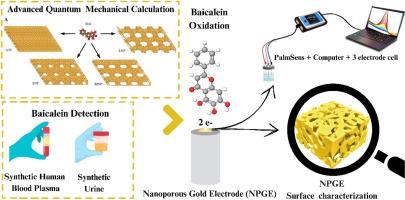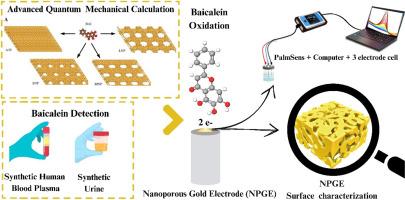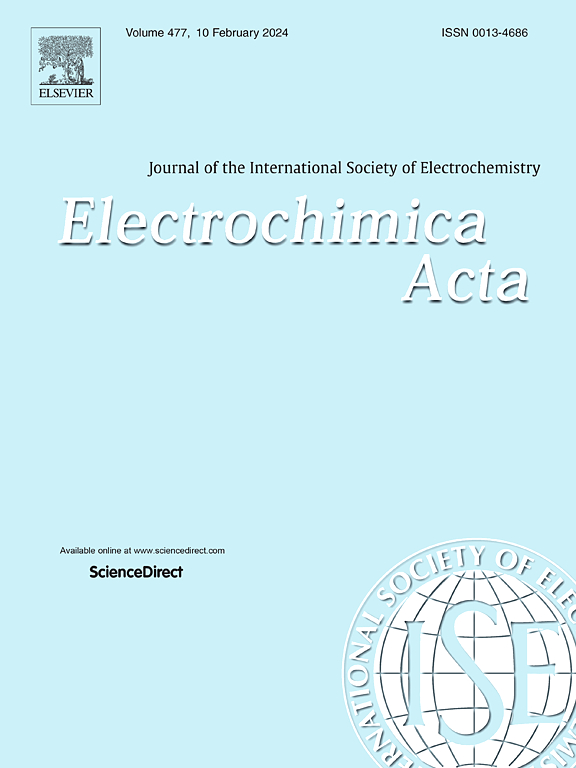将理论和实验见解融入纳米多孔金电化学,提高黄芩素传感性能
IF 5.5
3区 材料科学
Q1 ELECTROCHEMISTRY
引用次数: 0
摘要
我们介绍了一种用于灵敏检测黄芩素(BAI)的创新电化学传感方法,强调了一种简单的表面改性工艺。这项研究包括对纳米多孔金电化学行为的实践和理论研究。我们基于先进量子力学计算的理论分析表明,BAI 分子在金基基底上的吸附在能量上是有利的,从未修改的表面到多孔基底,吸附能不断增加。BAI 在未改性区域以水平排列的方式进行物理吸附,而在纳米多孔区域则通过穿透孔隙进行更强的化学吸附。在改性程度较低的表面上,相互作用能占主导地位,而在改性程度较高的表面上,由于基底反应活性的增加,畸变能变得更加重要。这些结果与物理化学特征相吻合,表明不同阳极氧化时间引起的纳米级改性解释了电极性能的变化。实验中,使用金电极 (GE) 和纳米多孔金电极 (NPGE) 进行了循环伏安法 (CV) 和差分脉冲伏安法 (DPV)。金电极在 H2SO4 中浸泡后进行表面处理,电位控制在约 +2.0 V,持续 40 秒。+2.0V,持续 40 秒,从而形成纳米多孔结构。经过优化后,采用吸附剥离伏安法(AdSV)测定 BAI。该方法的检出限(LOD)和定量限(LOQ)分别为 0.015 µmol L-1 和 0.045 µmol L-1(沉积电压=-0.25 V;沉积时间=50 秒)。此外,还将标准添加法应用于 NPGE,从添加的合成人血浆和尿液中回收 BAI,成功率在 93.4% 至 106% 之间。这种方法具有极佳的稳定性、精确性和准确性,受其他物质的干扰极小。此外,理论研究结果为纳米多孔金表面选择性电化学检测 BAI 提供了更深入的见解,为这一领域提供了新的视角。本文章由计算机程序翻译,如有差异,请以英文原文为准。


Integrating theoretical and experimental insights into nanoporous gold electrochemistry for enhanced baicalein sensing performance
We introduce an innovative electrochemical sensing method for the sensitive detection of Baicalein (BAI), emphasizing a simple surface modification process. The study encompasses both practical and theoretical investigations into the electrochemical behavior of nanoporous gold. Our theoretical analysis, based on advanced quantum-mechanical calculations, demonstrates that the adsorption of BAI molecule on gold-based substrates is energetically favorable, with adsorption energy increasing from an unmodified surface to a more porous substrate. BAI physisorbs on unmodified regions in a horizontal alignment, while it chemisorbs more strongly on nanoporous regions by penetrating the pores. On less modified surfaces, interaction energy predominates, whereas on heavily modified surfaces, distortion energies become more significant due to increased substrate reactivity. These results align with physicochemical characterizations, which reveal that nanoscale modifications, induced by different anodization times, explain the variations in electrode performance. Experimentally, cyclic voltammetry (CV) and differential pulse voltammetry (DPV) were employed using both a gold electrode (GE) and a nanoporous gold electrode (NPGE). The GE was subjected to surface treatment by immersion in H2SO4 and potential control at ca. +2.0 V for 40 seconds, resulting in a nanoporous configuration. Following optimizations, Adsorptive Stripping Voltammetry (AdSV) was used to determine BAI. The method achieved detection (LOD) and quantification (LOQ) limits of 0.015 µmol L-1 and 0.045 µmol L-1, respectively (Edeposition=-0.25 V; tdeposition=50 s). Additionally, the standard addition method was applied to the NPGE for recovering BAI from spiked synthetic human plasma and urine, with success rates ranging from 93.4% to 106%. This approach exhibited excellent stability, precision, and accuracy, with minimal interference from other substances. Moreover, the theoretical findings provided deeper insights into the selective electrochemical detection of BAI on nanoporous gold surfaces, offering new perspectives on this field.
求助全文
通过发布文献求助,成功后即可免费获取论文全文。
去求助
来源期刊

Electrochimica Acta
工程技术-电化学
CiteScore
11.30
自引率
6.10%
发文量
1634
审稿时长
41 days
期刊介绍:
Electrochimica Acta is an international journal. It is intended for the publication of both original work and reviews in the field of electrochemistry. Electrochemistry should be interpreted to mean any of the research fields covered by the Divisions of the International Society of Electrochemistry listed below, as well as emerging scientific domains covered by ISE New Topics Committee.
 求助内容:
求助内容: 应助结果提醒方式:
应助结果提醒方式:


